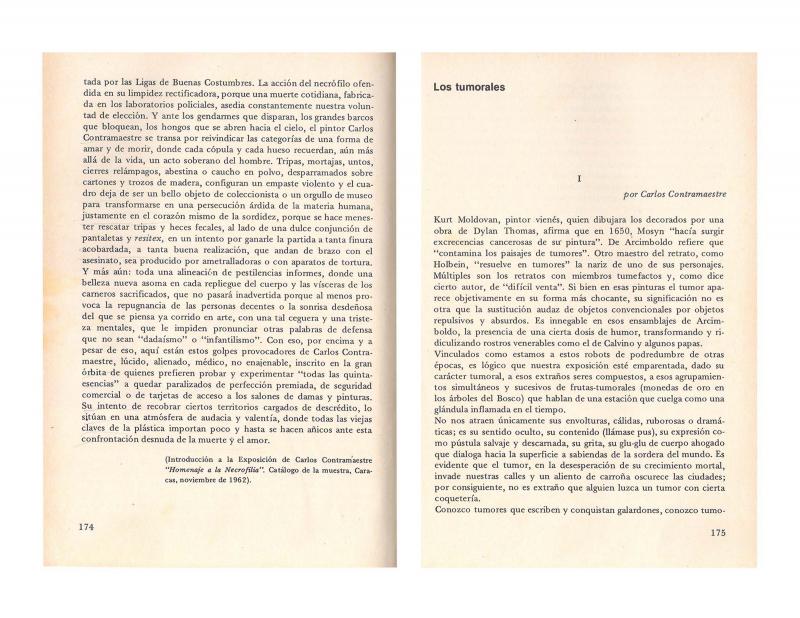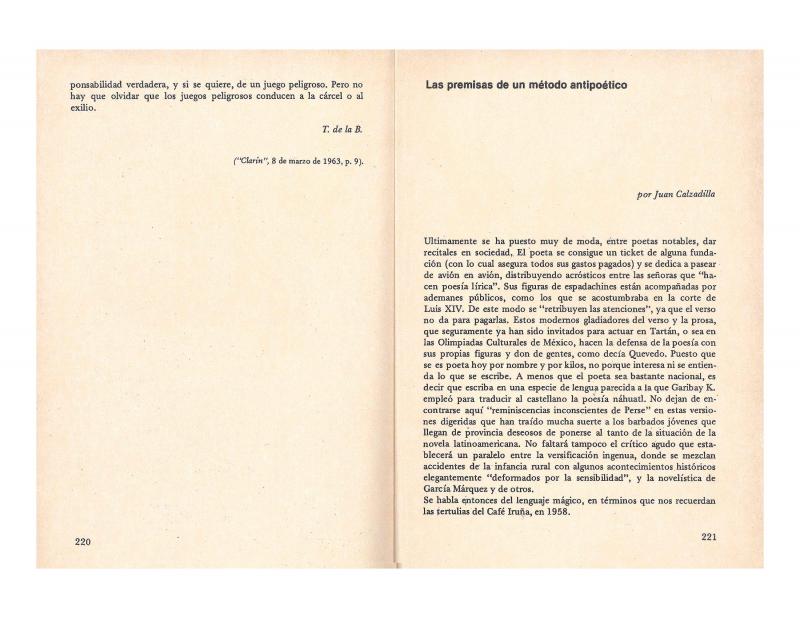Josep Maria Cruxent (1911–2005) was born in Spain, but gained Venezuelan nationality in 1945. He was a professional archeologist, serving as director and conservator of the Museo de Ciencias de Caracas (1944–63). His second artistic career started in 1959, when he embraced the informalist movement in Venezuela. The author of this catalogue introduction is artist Juan Calzadilla (Venezuela, b. 1931). In it he briefly described Cruxent’s involvement with the movement’s artists and main group exhibitions from 1959 to 1962. Both Cruxent and Calzadilla were active members of the avant-garde group of Venezuelan visual artists and writers El Techo de la Ballena, which was active from 1961 to 1968.
El Techo de la Ballena combined different disciplines (visual art, poetry, photography, film, actions, and others) to create revolutionary art that questioned and disputed traditional social and cultural values in the context of a decade riddled with political violence, which they mirrored in the realm of art. The framework for the group’s activity was the guerrilla movement, the formulations of the intellectual left, political repression, and a city deformed by accelerated and forced growth under the developmentalist model embraced by a recent democracy under Rómulo Betancourt (president from 1959–64). Their aesthetic was tied to Informalism with a strong dose of aggression to contest the values of abstract geometry, traditional landscape art, and even social realism; their strategy embraced subversion and provocation, the irrational and the surrealist. They published a good many texts—and three issues of the magazine Rayado sobre el Techo—and organized a good many exhibitions. The members of the group included Venezuelan artists Carlos Contramaestre, Juan Calzadilla, Caupolicán Ovalles, Edmundo Aray, Francisco Pérez Perdomo, Salvador Garmendia, Adriano González León, Fernando Irazábal, Daniel González, Gabriel Morera, Gonzalo Castellanos, and Perán Erminy; and foreign artists Dámaso Ogaz (from Chile), and J. M. Cruxent, Ángel Luque, and Antonio Moya (from Spain).
[For others texts by El Techo de la Ballena or its members, see the following in the ICAA digital archive: “Tercer manifiesto: ¿Por qué la ballena?” (doc. no. 1097576), where González León explains the nature of the group and its activities; and “Los tumorales I y II” (doc. no. 1097559), where Juan Calzadilla and Contramaestre present Contramaestre’s exhibition Los Tumorales, held at the Galería El Techo de la Ballena in Caracas in 1963; “Para la restitución del magma” (doc. no. 1060710); “Postales” (doc. no. 1279450); by Adriano González León “Investigación de las basuras” (doc. no. 1060324), “Homenaje a la necrofilia” (doc. no. 1097543), and “Rayado sobre el Techo de la Ballena: letras, humor, pintura” (doc. no. 1279400); by Rubén Santantonín “Arte cosa” (doc. no. 1280187), and excerpt from “Panflecosa” (doc. no. 1280171); “Cierta ballena” by Esteban Muro (doc. no. 1279483); by Juan Calzadilla “Contradicciones sobrenaturales” (doc. no. 1279531), “Por un arte de hoy...” (doc. no. 1279627), “Por un arte del mañana” (doc. no. 1279595), “Las premisas de un método antipoético” (doc. no. 1279547), and “Malos Modales” (doc. no. 1279515); “El Mordisco Contra el Arpón” by Edmundo Aray (doc. no. 1279434); “Salve, Amigo, Salve y Adiós” by Edmundo Aray and Efraín Hurtado (doc. no. 1279466); “Obbligato del Chatarrero” by Lawrence Ferlinghetti (doc. no. 1279418); and “Topatumba” by Oliverio Girondo (doc. no. 1280219)].










